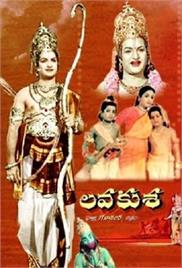Be Careful of Fake Websites. Always use HindiMovies.to domain & Join our Telegram Channel for Latest Updates.

Likes: 0
Views: 1.69K
This movie deals with the later part of Ramayana written by Valmiki Maharshi and depicts the lives of the sons of Rama & Sita.
Released: 1963
IMDb Rating: 7.3/10 (240 Votes)
Genre: Drama, Family, Hindi Movies, Musical
Stars: Anjali Devi, Taraka Rama Rao Nandamuri, Chittor V. Nagaiah, Kanta Rao
Directors: Rao C.S.R., Chittajalu Pullayya
Writers: Samudrala Raghavacharya
Year: 1963
Server 1 – Youtube
Introduction to Lava Kusa (1963)
The epic Indian film Lava Kusa, released in 1963, stands as a monumental piece in the annals of Bollywood cinema, celebrated not just for its grand narrative but also for its cultural and mythological significance. Directed by C. Pullaiah, an esteemed filmmaker known for his devotion to Telugu and Hindi mythological cinema, this movie is a vivid retelling of one of the most cherished stories from the Indian epic, the Ramayana, focusing particularly on the lives of Rama's twin sons, Lava and Kusa.
Overview of the Storyline
The film is deeply rooted in Indian mythology and explores themes of family, valor, and duty. It narrates the saga of Lava and Kusa, the sons of Lord Rama and Sita. The story unfolds with the familial and emotional turmoil resulting from their separation and eventual reunion with their father, Rama. This story resonates with audiences due to its portrayal of righteousness, devotion, the trials of family bonds, and the triumph of good over evil.
Plot Summary
After Sita is exiled by Rama due to societal pressures and rumors regarding her chastity, she finds refuge in the hermitage of sage Valmiki, where she gives birth to twin boys, Lava and Kusa. The boys grow up unaware of their royal lineage but inherit qualities of heroism and righteousness. The narrative thickens as the twins unknowingly confront their father during a crucial episode where Rama attempts to perform the Ashwamedha Yagna. The culminating reunion and acknowledgment of father and sons provide a powerful emotional climax that reaffirms familial bonds and dharma.
Main Cast and Their Roles
Direction and Writing
The visionary director C. Pullaiah helms the film with a clear reverence for the source material. Known for his expertise in adapting mythological epics to the silver screen, Pullaiah's direction ensures that the film is both an epic spectacle and a heartfelt family drama. The dialogues and screenplay emphasize the emotional and moral dilemmas faced by the characters, bringing the ancient tale vibrantly to life.
The screenplay and writing retain close fidelity to the revered texts, allowing the audience to immerse themselves in the rich cultural tapestry of the Ramayana. The writers skillfully balance the grandeur of the myth with intimate human emotions, making the story relatable and moving.
Musical Elements and Songs
As a Bollywood musical rooted in Indian mythology, Lava Kusa features a captivating soundtrack that enhances the narrative experience. The music was composed by the legendary duo of Ghantasala and Viswanathan-Ramamoorthy, whose compositions beautifully blend classical Indian music with the cinematic demands of storytelling.
The songs in the movie are soulful and range from devotional hymns to expressive ballads reflecting the characters' emotional states. Each song is delivered with magnificent vocal prowess by some of the era's most celebrated playback singers, such as Ghantasala himself, Lata Mangeshkar, and P. Susheela. Their melodious voices impart life and depth to the music, reinforcing key moments of the film.
The lyrics echo the spiritual undertones and moral themes of the film, enabling the audience to connect with the narrative on a deeper level. The songs serve as both storytelling devices and emotional enhancers, making them integral to the film's enduring appeal.
Cinematic Techniques and Legacy
Lava Kusa is noted for its impressive set designs, elaborate costumes, and choreography, all of which contribute to the grandeur and authenticity of this mythological epic. The cinematography beautifully captures the narrative’s dramatic moments and the serene landscapes of ancient India, enhancing the film's immersive quality.
This movie holds a special place in Indian cinema's history, not only because of its artistic merit but also because of its impact on popular culture. It introduced many audiences to the tales of Lava and Kusa, making these characters household names. The film’s success encouraged further productions of mythological themes in Bollywood and beyond.
Conclusion
Lava Kusa (1963) is a landmark Bollywood film that masterfully combines drama, family values, mythology, and music. With stellar performances by N.T. Rama Rao and Anjali Devi and the expert direction of C. Pullaiah, it brings the timeless story of Lord Rama and his sons alive with emotional depth and visual splendor. The film’s musical score remains a treasured aspect of its legacy, enriching the narrative and leaving an indelible mark on audiences. For anyone interested in Indian mythology, classic Bollywood cinema, or epic storytelling, Lava Kusa is an essential viewing experience that stands the test of time.